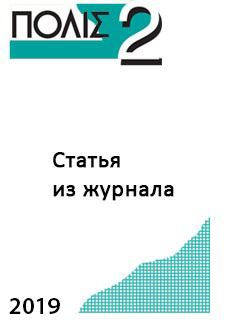Online shop of "Polis. Political Studies" Journal
We in the world, the world in us
vanov E.A., Isayev L.M. On Methods of Estimating Current Condition and of Forecasting Social Instability in Central Asia. – Polis. Political Studies. 2019. No 2. P. 59-78 (In Russ.)
Free!
Central Asia, Arab Spring, Post-Soviet space, social revolution, political (in)stability, political regimes, political risks, political foresight.
This paper examines sustainability factors of political regimes in Central Asia after the Arab Spring. According to the contemporary political notion, Central Asia consists of five states, viz. Kazakhstan, Uzbekistan, Kyrgyzstan, Tajikistan, and Turkmenistan. The countries of Central Asia have a number of similarities with the states of the Arab world, which became the epicenter of revolutionary movements after 2011. These characteristics are – a high share of the youth population, social inequality and fragmentation, poor quality of state governance, geographical proximity to instability areas (Afghanistan, the Middle East), etc. Thus, many experts expected that the wave of revolutions would come to Central Asia. However, political regimes in the region have managed to keep stability. The research tests (de)stabilization factors by means of regression analysis. The core of the model includes analytical tools applied for the Arab Spring events. Five key factors are used: 1) extent of society and elite fragmentation 2) share of marginal groups in the population (jobless youth) 3) type of a political system 4) existence / lack of the large-scale conflicts in the recent past 5) extent of international actors’ intervention into Central Asia home affairs. As a result, it was revealed that stability in the Central Asian region is provided, first of all, with low concentration of the marginal youth in the big cities as a considerable part of youngsters are the labor migrants who works abroad. The type of political system is an important factor too. As well as in the Arab world, the Central Asian autocracies and imitation democracies are exposed to socio-political destabilization more than monarchies or consolidated democracies. The situation becomes complicated as Central Asian political regimes have lack of procedures to transfer political power. Democratic institutions are poorly developed and distorted there. Moreover, state leaders have to face a vague choice to select successors. In addition, stability was affected by consolidation of elite around current leaders who subdued ethnic or clan loyalty in favor of personal loyalty to them. At the same time, fragmentation strengthening can considerably increase probability of inner conflict and further destabilization. We found out that Tajikistan and Uzbekistan have the largest potential for destabilization. Kyrgyzstan and Turkmenistan, on the contrary, neutralize the arising prerequisites to tension strengthening within the country. Basing on regression modeling, we compared Central Asia states with Arab ones. By the moment, any of Central Asia states has not reached the level of potential instability at which Arab Spring revolutions began. Nevertheless, dynamics of recent years indicates growing probability of protest movements in next years.
 English
English Русский
Русский

Reviews
There are no reviews yet.